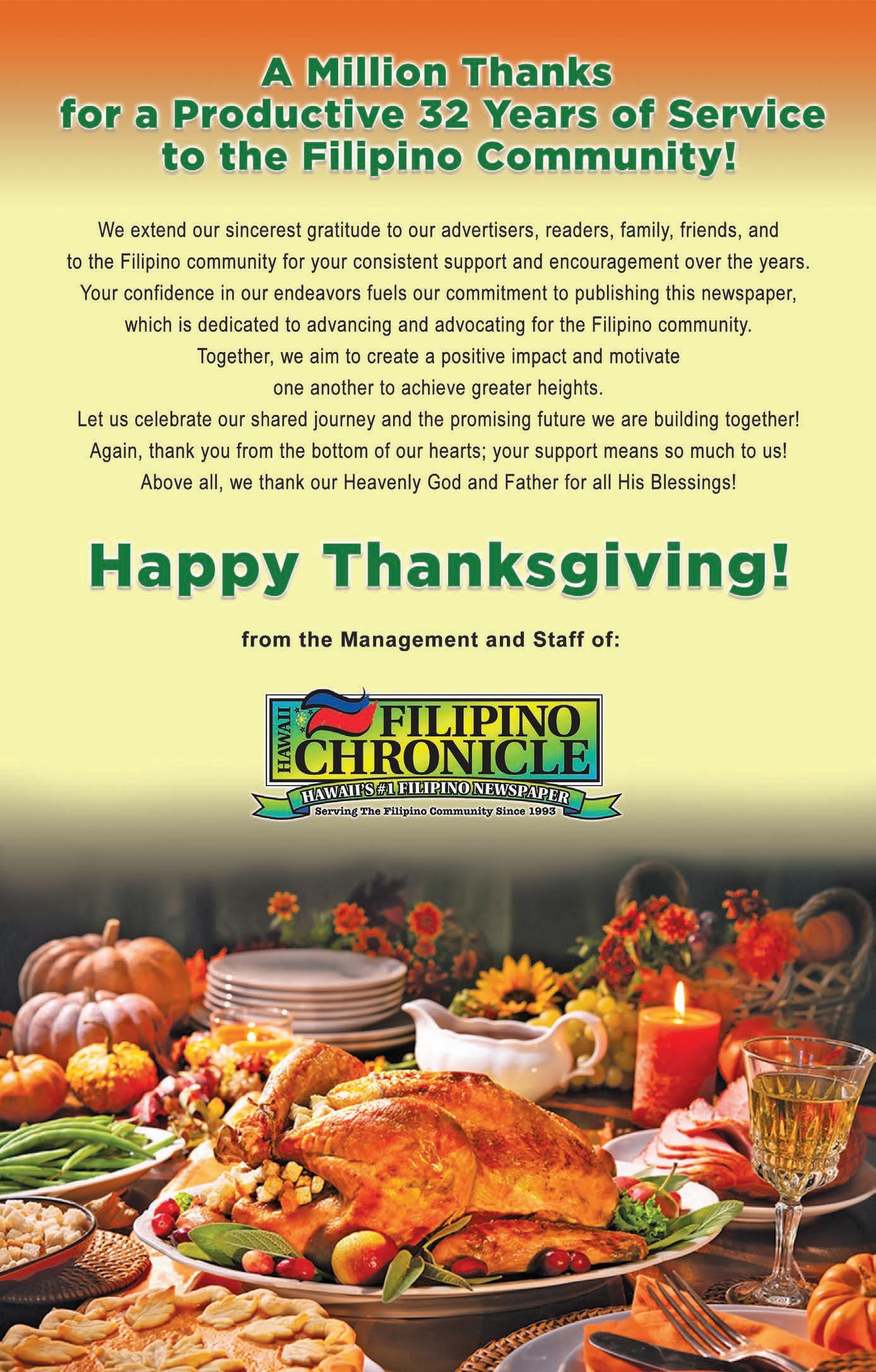






By Jim Bea Sampaga
According to the 2020 Census, 383,200 people in Hawaii are of Filipino ancestry. That means 1 in every 4 Hawaii residents are Filipino or part Filipino.
As the second largest group in Hawaii, the Filipino community is part of the history and future of the State of Hawaii.
For the past three decades, the Hawaii Filipino Chronicle (HFC) has been at the forefront of news and stories that are relevant and essential to the Filipino community in Hawaii.
HFC has covered the local election in Ha-
waii and the national election in the United States. The newspaper has featured Filipino Americans running for local public office in both Hawaii and in recent years, in California.
HFC’s cover stories highlight the policies of numerous mayoral, senate, and presidential candidates over the years to empower the Filipino community with knowledge and support to cast their votes on the ballot.
Not only does HFC empower the Filipino community to vote in the U.S. elections, but the newspaper also closely follows the presidential elections in the
Philippines to educate Filipino citizens in Hawaii.
Furthermore, the newspaper also highlights the achievements and the struggles of the Filipino community over the past years.
The newspaper championed the doctors, nurses, and other front-liners who were protecting and serving the community during the COVID-19 pandemic while also highlighting their struggles in their line of fields.

HFC covers the labor struggles of various industries in Hawaii, including the medical and hotel management fields that employ a majority of the Filipino community.
Over the years, HFC has celebrated and continues to provide a platform for Filipino businesses, artists, academics, and professionals through its feature articles in every publication issue.
Numerous colum-
nists from various fields of journalism, politics, medicine, and academics have been contributing articles to the newspaper to share their knowledge and opinions that provide discourse and engagement among the community.
(continue on S12)
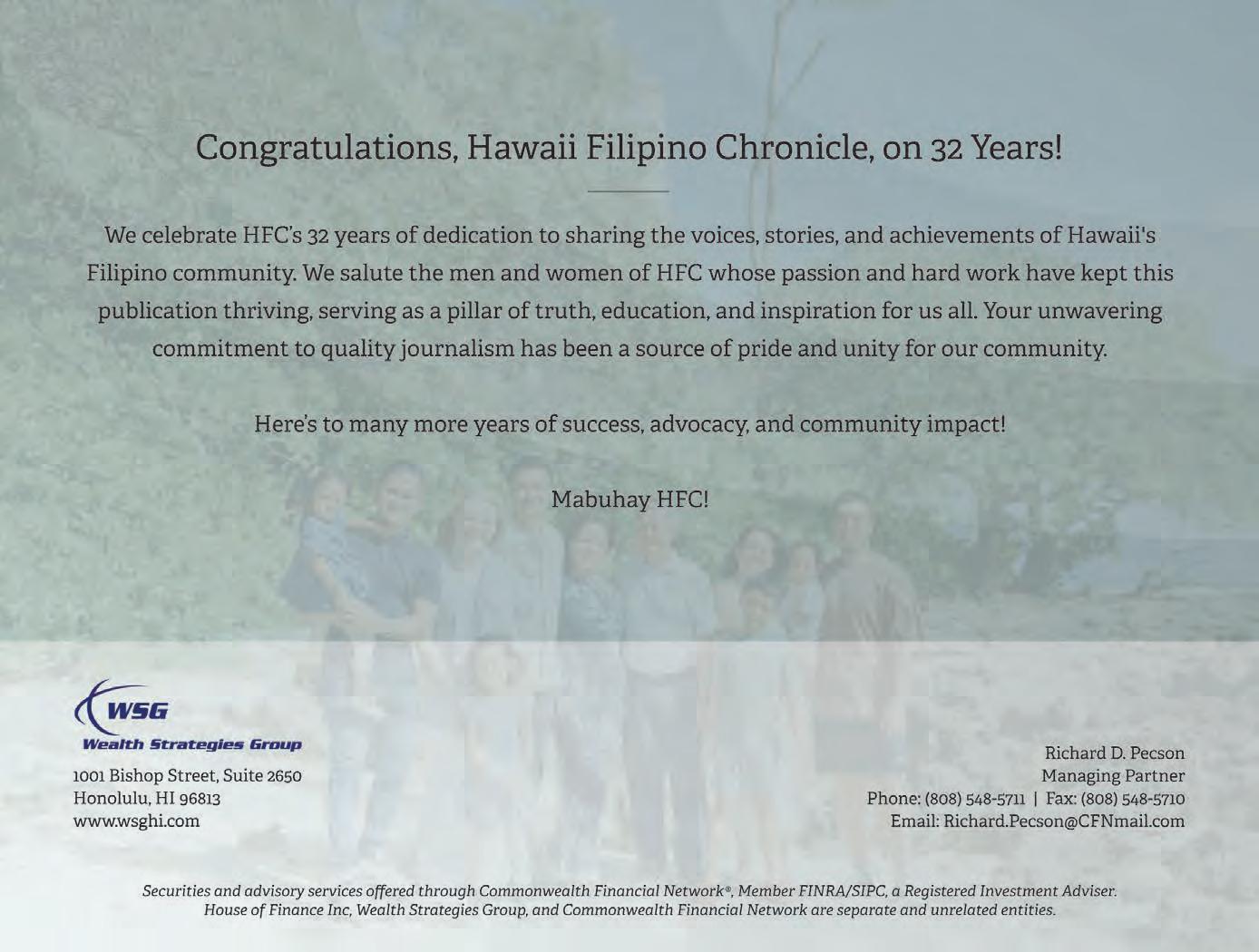
The Hawaii Filipino Chronicle is celebrating its 32nd anniversary this year. Several years ago, it seemed likely that the Chronicle would close, as the print media - especially ethnic media - faced numerous challenges. It is estimated that by the end of this year, one-third of all newspapers in the U.S. will shut down due to financial hardship. The Hawaii Filipino is not immune to these devastating economic headwinds sweeping through the entire industry. Even our long-time printer, the Hawaii Hochi, which had been with us for 32 years, has shut down permanently.
Despite these difficulties, we are incredibly grateful to have survived and overcome these challenges. We sincerely thank the Filipino community and all our supporters who have contributed in their own way to the success of the Filipino Chronicle. Above all, we thank our Almighty God for blessing us in this undertaking.
During our journey, so much has happened that it’s impossible to pinpoint singular moments that fully encapsulate this remarkable journey. Perhaps, the closest word we can think of that resonates with us is “hope” - the idea that embodies our unwavering optimism and the belief that we can continually come together to address challenges, uplift our communities and foster positive change.
Hope serves as a guiding force, encouraging us to envision a brighter future while celebrating the successes and stories that unite us all. We can look to some events our newspaper has covered that exemplified hope - the election of the nation’s first and only governor of Filipino ancestry, the establishment of our beloved Filipino Community Center, the largest of its kind in the United States and recording the rise of Filipinos as the largest ethnic group (second largest racial group) in Hawaii. But this sense of hope has not been our only guiding principle. We’ve also relied often as a driving force a desire to correct injustice and to meet our community’s needs. The Filipino Chronicle has consistently stood with the community to advocate for causes that address our unique needs and concerns.
From the newspaper’s inception, we knew that we were on track to creating something special.
We recognized the connection between empowerment and voice. News is still monopolized by big media locally, but the Filipino Chronicle has provided our community with an influential alternative source of information as an ethnic newspaper that is serious, issue-oriented, and culturally sensitive.
Over the years, we’ve seen uplifting and disturbing trends in our nation and state. Through our advocacy in editorials and cover stories, we’ve shown restraint when needed, while in others, we boldly framed urgency at hand, calling for change. Of late, our news sections have carried extraordinary significance with reports on controversial changes to immigration policies and proposals to cut social safety nets.


The news constantly changes based on society’s values. For us, one area of consistency from the beginning has been promoting our culture and traditions, not only through articles but also through publicity of cultural events spearheaded by Filipino clubs and organizations -- the most anticipated event being the annual Filipino Fiesta.
As we reflect on our journey, we have discovered and imparted significant lessons that define our collective success: we are stronger as a community working together, and in order to uplift our community, we must be active and give back by sharing our talents and resources.
We must also recognize that our economic prosperity, health outcomes and educational attainment are often linked to political policies. Most people often overlook this last point, but this is where the media, the “Fourth Estate,” asserts its critical role. It serves the purpose of guarding the people’s interests over the interests of the powerful. By holding leaders accountable and exposing injustices, the media ensures our voices are amplified and empowers our community to ensure that our rights are protected.
Championing this cause is not just a primary goal; it is our obligation to build a fair and equitable society for all.
Through the years, we’ve also seen journalism as an industry undergoing major changes, mainly due to technological advances and market forces. The Internet has made aspects of the news business easier; but it has also created financial challenges for our industry as we struggle to carve a online niche for ourselves. It’s not an overstatement to say that running a newspaper has been a financial strain but we remain steadfast and committed to carrying on because of our love for our community.
To give back to our community and support Filipino students pursuing careers in journalism and mass communication,we are pleased with our decision to launch the Hawaii Filipino Scholarship program that began in 2019. We are awarding $2,500 to a student of Filipino or part-Filipino ancestry who is majoring in journalism or mass communication. Proceeds from our anniversary supplement will contribute to our scholarship awards program. Thus far, we have awarded scholarships to five recipients.
Lastly, we would like to express our gratitude to our hardworking staff, editors, columnists, distributors and contributors. A BIG MAHALO to our advertisers! Thank you to our many collaborators in the Filipino community. This publication is about you. We invite you to join us on our journey and show your support as we move forward together. Our success has been your success. We are not giving up yet! Our commitment is enduring and for the long haul! Mabuhay to the Hawaii Filipino Chronicle and to Hawaii’s Filipino community!
Here’s to another 32 years of successful reporting!
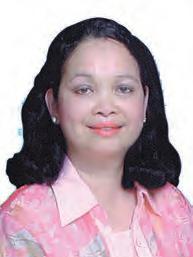

By Edwin Quinabo
In July 32 years ago, Dr. Charlie and Chona Montesines-Sonido established the Hawaii Filipino Chronicle (HFC), a newspaper born under the premise that Hawaii’s Filipino community can tell their own stories, and that storytelling and data-based reporting can spur a new generation into action and harness empowerment.
The Sonidos aimed to front a new contrarian offering to the then negative reporting by the mainstream media on Hawaii’s Filipino community -- particularly on its immigrant population – that often frustrated, even angered Filipinos throughout the 1980s and earlier decades.
“We started the Hawaii Filipino Chronicle to give a variety of communication channels where the Filipino community can voice their sentiments, achievements, aspirations and challenges. We started it to showcase our culture and perpetuate our traditions. We started the Chronicle to advance, advocate and empower Filipinos in the community,” Montesines-Sonido said, who is also HFC’s managing editor.
The creation of the HFC signaled to the community then, in the early 1990s – a community still fragmented – that as individuals in pursuit of a better life that they are not alone. Further, that there is a mechanism to
gather these multiple individual voices and share them in the medium of an ethnic newspaper. So, began an ambitious and transformative project to fashion a new narrative of one of Hawaii’s largest communities on the rise.
Upon HFC’s launching, in a smart PR and costly move, tens of thousands of Filipino households received a free copy of the newspaper via mail for several months that helped to make an immediate promotional impact. Soon after, the HFC could be found at various outlets throughout the state. Today, a free e-copy of the HFC can be accessed digitally in addition to a hard copy at outlets or by subscription. It has been published weekly and biweekly with thematic supplements throughout each year.
To advance their vision, the HFC publishers enlisted like-minded mostly Filipino writers, community leaders, academics, professionals from various fields, activists, cultural experts -- who all shares a vision for community engagement and advancement.
With a burning curiosity and investigative skill, HFC reporters set out to find answers on issues that the rest of the state and international community face, but with specific focus on what Filipinos think, how they are personally impacted, what’s in it for their community
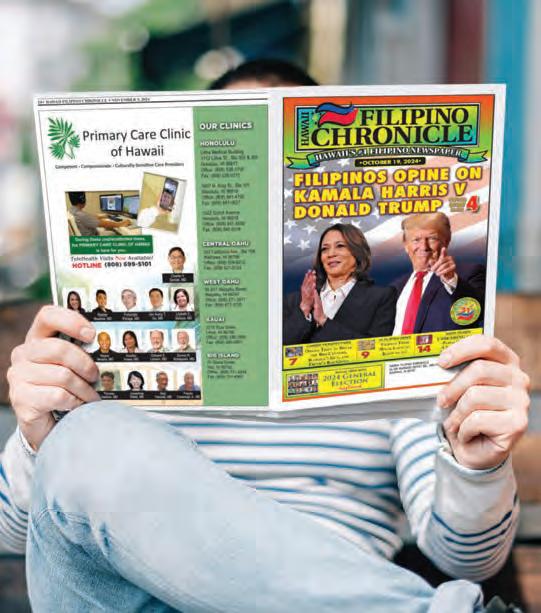
and where the Filipino community wants to be. What the HFC uniquely presented was placing a Filipino context on the relevant issues of the day in the newspaper’s editorials, cover stories, news, features and columns.
HFC’s increasing popularity drew experts in various fields, local politicians, organizations and businesses in the greater Hawaii community to use the newspaper as a springboard to target the Filipino community. They started to submit commentaries, news and regular columns which not only informed the HFC’s target audience to have greater awareness of the issues and events happening across the state, but it also stimulated active participation of Filipinos outside of their communities to become partners in the greater community.
This transition from the Filipino community being a mostly insular community of the 1980s to what later became a movement in the 1990s called “mainstreaming,”
opened the doors to increased Filipino political engagement, appointments to commissions, boards and more Filipinos themselves seeking public office. The HFC was an integral part of that movement and reported on it in their early column, “On the Move” which also focused on Filipinos climbing up the corporate ladder.
“Today as a resource and reference material, the mainstream media, academics and students often tap the HFC for the newspaper’s extensive reservoir of chronicling the Filipino community over decades,” Montesines-Sonido said.
She adds, during each election, the HFC has been a credible data source on the issues and political candidates.
“Candidates, both Filipinos and non-Filipinos, reach out to the HFC to share their platform with the Filipino community, including those running for the highest offices like governor, mayor, the U.S. Senate and House. For decades each election
year, we conducted our own extensive election polling of the Filipino community that drew attention from candidates and the local mainstream media,” Montesines-Sonido said.
HFC associate editor Dennis Galolo said, “Two instances come to mind in which the Chronicle has benefitted both the Filipino community and the State. First, during election year, the Chronicle has played an important role in introducing aspiring political candidates to our readers. One-on-one interviews, columns and personal profiles provide our readers with more knowledge on the various issues and platforms that these candidates support. The result is a better informed and smarter voting populace.
“Also, during the COVID pandemic, hurricanes, floods and other emergencies, the Chronicle was a source of information for the Filipino community, particularly for those who do not speak English. The Chronicle got the word out to our readers promptly and efficiently,” Galolo said.
Dr. Edna Bautista, Ewa Beach, a staff member since 1995, said “Our Filipino community has benefited from our newspaper as a reliable source of information that bridges Hawaii’s longtime locals of Filipino heritage to newcomers from the Philippines. The (continue on S5)
Chronicle covers state stories (news, personality profiles, cultural events and more) and features articles from the Philippines and the mainland. I think our readers appreciate the variety of information in our newspaper that addresses our specific interests as Filipinos.”
Decade after decade, HFC staff transitioned with the times, were involved in community engineering that helped to keep Filipinos alive during COVID-19, sound alarm bells that there is a physician shortage crisis in the state, guide newly arrived immigrants informing them legally how to become a fullfledged citizen and push hard for political representation to have a seat at the table of political power. The HFC was a source of information after the deadly Maui brushfires that disproportionately devasted the Filipino community. It helped direct this community to available resources and updated them on the latest assistance from the government.
HFC’S community engineering is anchored in the power of anecdote, of personal stories told by the many Filipino politicians HFC interviewed like former Gov. Ben Cayetano, the only governor in the U.S. or community leaders like Eddie Flores Jr and Roland Casamina who through HFC solicited the community’s support for the construction of the largest Filipino Community Center outside of the Philippines. The dream of the FilCom Center was eventually realized and is situated in the historic Filipino plantation town, Waipahu.
Central to its goal of
community engineering, the HFC has done cover stories on diverse and relevant issues like immigration reform, the opioid crisis, student debt, Asian hate crime, the outpricing of locals from paradise, rent shortage, inflation, wars, poverty, recessions, homelessness, Medicare, Social Security, high cost of prescription drugs, domestic abuse, mass shootings and gun violence, police brutality and policing reform, universal healthcare, underrepresentation of Filipinos in higher education in Hawaii, growing suicide epidemic among youth, mental illness, preparing for retirement, small businesses in Hawaii, Hawaii tourism, Filipinos and organized labor, Hawaii frontline medical workers, unemployment, infrastructure, top careers for students, high cost of Hawaii real estate, and AI and tech impact on jobs, to name a few.
Filipino scholars have played an enriching role in the HFC, scholars who share their expertise in Filipino culture to be passed on generationally – the unique Pasko practices, the Catholic Santacruzan and Undas traditions, preservation of Philippine languages Tagalog, Ilocano, Cebuano, and education on Philippines history and book reviews written by historical and contemporary Filipino writers.
“I enjoy writing stories about the Filipino culture and traditions. One of my most memorable was a cock-fighting article that I wrote because I was able to attend a live cockfight in Waialua on a Sunday morning. I also wrote an article on Filipino myths and legends for our Hallow-
een issue. I learned a lot about legends and folklore from the Philippines that I never knew about,” Galolo said.
HFC readers say highlighting Filipino role models has been inspiring the community for generations. It has been one of the most effective community engineering toward empowerment, Montesines-Sonido said. “We’ve interviewed Filipino trailblazers like Lee Ellen Buenconsejo-Lum, MD, FAAFP who was the interim Dean of the University of Hawaii Mānoa (UHM) John A. Burns School of Medicine (JABSOM), the first dean of Filipino ancestry at UHM and national leaders like Loida Nicolas Lewis, the widow of TLC Beatrice founder Reginald Lewis. Loida later became CEO of the billion dollars company. We’ve done reporting on Rep. Robert Cortez Scott the first and currently only sitting member of Congress of Filipino ancestry who hails from Virginia and recently interviewed Ysabel Jurado who made history this General Election by becoming the first Filipino elected to the Los Angeles City Council.”
Bautista said, “As a writer/photographer for HFC, I get to meet a lot of Filipinos who are doing positive things to make our community proud-from entrepreneurs and artists to government officials and religious leaders. I am honored to be able to write about them and share their stories with others. As a foodie, I enjoyed writing about Fr. Leo Patalinghug, the “Filipino cooking priest.” He is funny, talented, smart and inspirational. I
“While the Chronicle may not follow a traditional business model, its value as a community service is undeniable. We believe it plays a crucial role as the voice and advocate for our community, fostering connection and support that goes beyond financial metrics. Supporting the Chronicle means investing in a vital resource for our neighborhoods. And this is what matters to us. The Chronicle is a labor of love. A love for our community and our people! It [HFC] serves as a symbol of perseverance and our commitment to the community. Despite the overshadowing presence of larger corporate media, the print media, particularly ethnic media, still plays a vital role in sharing diverse voices. In recent years, while over 2,000 newspapers have closed or merged, this situation presents an opportunity to rekindle the spirit of local journalism and ensure that even the most remote communities remain connected and informed.”
– Dr. Charlie and Chona Montesines-Sonido HFC Publishers, Executive and Managing Editor
was lucky to eat his food, too.”
The HFC has been an information center for community events like the annual Filipino Fiesta and Flores Parade, the Ohana Medical Mission Charity Ball, Doctors on Stage musical concerts to benefit the Bayanihan Clinic Without Walls, the annual Filipino Food Week, the annual Taste of Waipahu, the annual Philippine Independence Day Gala (Kalayaan Gala), Pasko sa FilCom, Pasko Parol Making at HOMA, Pinay Powerhouse III, annual Great Malunggay Festival and Parade, welcome banquets for Philippine presidents and other dignitaries, and multitudes of Filipino club events.
Labor of love, surviving through tough times
The 1990s saw the acceleration of the internet that marked the beginning of hard times for most print media. Many newspapers were at the brink of discontinuation, forced to scale back, merge or fold altogether. “The Chronicle should have been closed, by every measure, a long time ago. As a business model, the print media, especially the ethnic media, has been overshadowed by big corporate media and has seen its better days,” Montesines-Sonido said. She cites reports that in the last few years, after the pandemic, over 2,000 newspapers have either closed or merged leaving 1,300 communities without local news coverage.
The Sonidos absorbed financial losses to keep the HFC running and remained committed to their vision. “It
[HFC] serves as a symbol of perseverance and our commitment to the community. Despite the overshadowing presence of larger corporate media, the print media, particularly ethnic media, still plays a vital role in sharing diverse voices. In recent years, while over 2,000 newspapers have closed or merged, this situation presents an opportunity to rekindle the spirit of local journalism and ensure that even the most remote communities remain connected and informed.”
Dr. Sonido elaborated, “While the Chronicle may not follow a traditional business model, its value as a community service is undeniable. We believe it plays a crucial role as the voice and advocate for our community, fostering connection and support that goes
beyond financial metrics. Supporting the Chronicle means investing in a vital resource for our neighborhoods. And this is what matters to us. The Chronicle is a labor of love. A love for our community and our people!”
In observance of the HFC’s 27th anniversary in 2019, the Sonidos established the HFC scholarship. Dr. Bautista who served as HFC journalism scholarship chair, said “The Chronicle reached out to our Filipino youth by offering journalism and mass communication majors a scholarship. Since 2019, HFC awarded $10,000 in scholarships which helped our young local Filipino college students financially, especially during the pandemic. Not only did they gain
media experience by writing for our newspaper, but they told me that they also learned more about their Filipino heritage.”
Nieva Elizaga, a community leader, has been reading the HFC since the newspaper’s start. She congratulated the HFC on its 32nd anniversary. “It has been a labor of love for Chona and Charlie {Dr Sonido}. Thank you for publishing a newspaper that has kept its high quality all these years. Your editorials are always well written and thought provoking. The whole paper is worth reading. Keep publishing it.” What she would like to see are more articles on places to visit in the Philippines. It seems there are more and more spots to see.

owner of a beauty salon and jewelry store, Mililani, said “the HFC has been publishing community events for years. Most Filipino organizations have their yearly calendar of events published in the HFC calendar. This is one way of connecting ourselves with the Filipino community. Attending organization events like the installation of new officers is a way to meet new and old friends and relatives.”
The HFC invites Filipino clubs, professional, civic and religious organizations to submit their events which are posted in the HFC calendar. Events in the greater community of importance or could be of interest to the Filipino community are also published. Montesines-Sonido said “it’s a way to foster community engagement which is key to community unity and participation.”
Mary Ann Cabales, Health Information Specialist, East Honolulu, said “the HFC kept readers such as me informed on news and other important events particularly from the Philippines. In fact, I would like to see more news coverage about politics, celebrities and other important people from the Philippines.”
Genevieve Cadiz, business
the communities they’ve moved to.”
The Sonidos said they would like to extend their heartfelt gratitude to the Filipino community for their unwavering support throughout the years. “Your encouragement and support have been instrumental in our journey, and we truly appreciate everything you have done for us. We also want to express our sincere thanks to all our advertisers, friends, and supporters. Your contributions have played a crucial role in making our celebration of the 32nd Anniversary possible. This milestone would not have been reached without your generosity and commitment.
Cadiz adds, “It’s common at Filipino events for politicians and state officials to attend. So, it’s an opportunity for our Filipino community to get to know them. I would like to see more stories written in our own language like “Ilocano” or “Tagalog” so the old-timers like the Sakadas can understand more what they are reading. I also admire some of your staff who are friendly and assertive but very approachable.”
Rowena Salvador, retired, Moanalua said, “I like to read about the Filipino community on the mainland that the Chronicle does often, featuring the movers and shakers and Filipino communities in California and other states like Nevada.
Our local Hawaii Filipino community is all over the mainland so it’s interesting to know about
“Moreover, we want to highlight the remarkable efforts of our dedicated staff. Their hard work and relentless dedication have been the backbone of our success. These individuals have spent countless hours, often working late into the night, to ensure that we consistently publish high-quality issues of the Chronicle. Their passion and perseverance are what allow us to serve our community and share important stories each week. Thank you all for being part of this incredible journey! Please continue to support us as we journey together to shape a brighter community for all of us!”
The HFC has garnered multiple awards including the Small Business Administration’s Journalist of the Year in the City and County of Honolulu in 2006. It has been awarded accolades from the Hawaii State Senate and State House for achievement in journalism.
By Gary Hooser
During my 30 years of work in politics and policy, it’s become undeniably clear that our voice is the most powerful tool in our tool box.
We can and we should vote, of course, but speaking out on issues, and letting the world know our thoughts, feelings, goals, and hopes - is the most important tool for change that we have.
Unfortunately the world of mass media has become a morass of content, with opinions too often disguised as facts, and marketed as “click bait” designed to sell advertising.
Mahalo to the Hawaii Filipino Chronicle for the valuable role they play in helping to amplify the many local voices of
change that might otherwise go unheard. By providing a straight-forward community based forum for coherent voices to tell their own personal stories - our world is a better place.
Telling stories and voicing opinions allows the writer to publicly “come out” on issues and values. Often when one person “comes out”, it gives confidence to others to do the same on perhaps an issue they might otherwise feel is too controversial or that they are in the minority on, and thus they are hesitant to speak about.
The issue could be about the tragedy occurring in Gaza, or the right for workers to be paid a living wage, or medicare for all, or that affordable

housing is a basic right, or a woman’s right to choose, or yes…LGBTQ rights.
The bottom line is when one person begins to speak and write on issues, values, opinions, and goals - others are motivated to do the same.
When people start talking out loud about these issues, then others are empowered also to join in the conversation, and soon “policy-makers” hear the chorus and start pushing policy in the direction of the conversation.
This is how the tide of public policy shifts from
one position to another.
Our Council-members, Representatives, and Senators serve at the pleasure of the voters. If the voters are increasingly vocal in their support or opposition of various public policy issues/positions - the elected representatives will ultimately notice and move in the direction of the voter. This is a fact of life in electoral politics.
Those who serve in elected office love their jobs and they can remain in office only if they win the votes of residents. Thus it’s critically important that each of us continue to raise our voices in public support and in opposition to the issues important to us.
We must use all methods of communication to ensure our individual and our collective message is
strong and shared widely: Letters to the editor, emails and telephone calls to elected policy-makers, direct communications with our own friends and networks, holding signs and marching with others - and yes absolutely with strong support of those media sources that provide a coherent forum for diverse opinions - like the Hawaii Filipino Chronicle.
Please join me today in raising our voices together, united in purpose with people across the islands and in fact across the globe, in support of a world that puts people and the planet first, above greed, above corporate profits, and above ego and personal aggrandizement.
GARY HOOSER is ta former Hawaiʻi State Senator and Majority Leader.

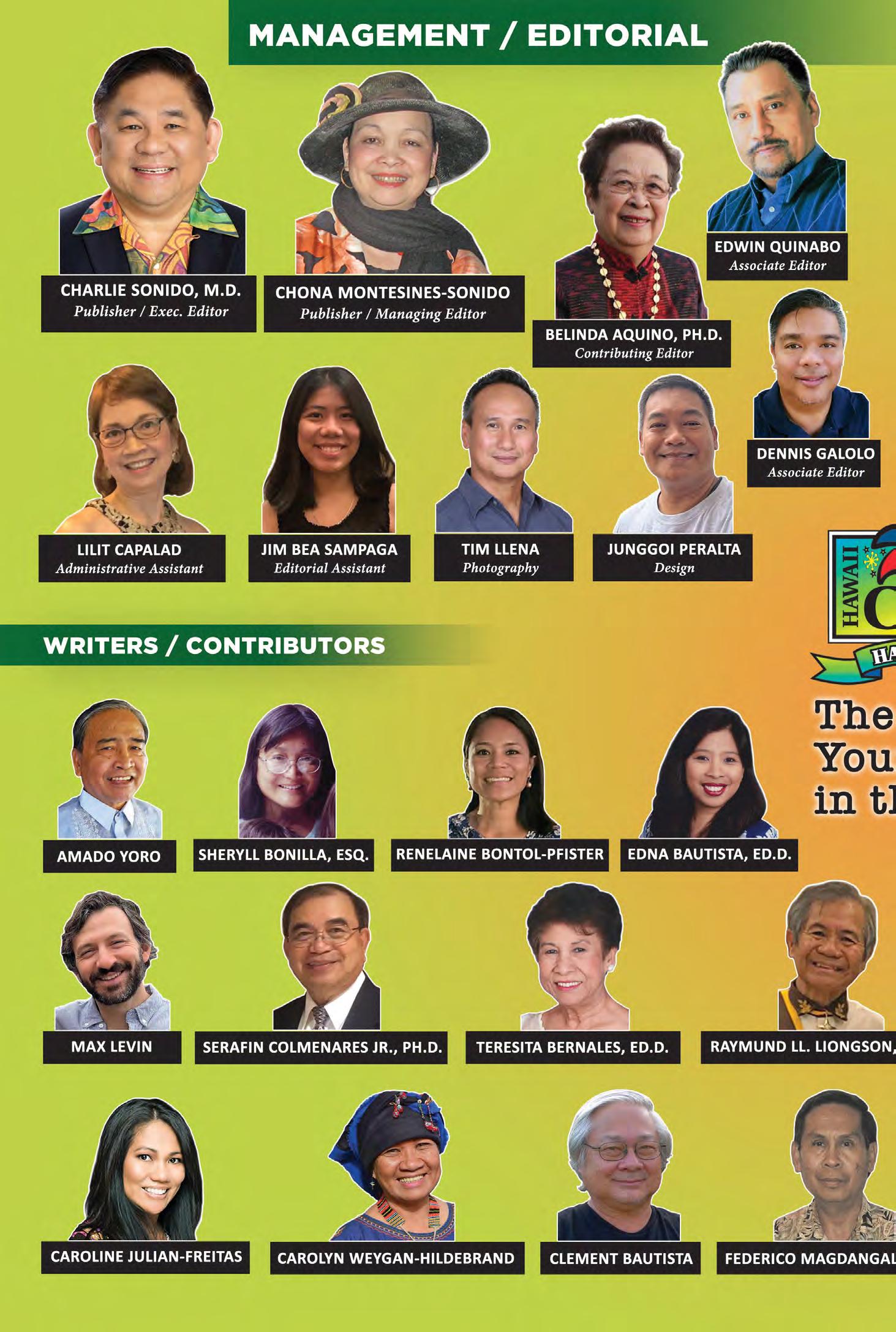

By Carlota Ader
For the past 32 years, the Hawaii Filipino Chronicle (HFC) has been serving, representing, and championing the Filipino community in Hawaii. To celebrate this milestone, we reached out to HFC readers to know what made them support this Hawaii-based Filipino ethnic newspaper.
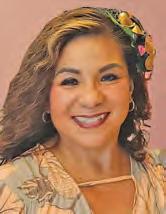
Lani Jimeno
Parent Home Educator with Non-Profit Program, Waipahu
’I’m a local-born Filipino and one of the reasons why I like to read the HFC is that I want to embrace our culture and heritage and to connect myself with the Filipino Community. As a Parent Home Educator, I work with seniors and young children teaching dances and exercise and I have the chance to know them, especially the seniors from the Philippines. I get to know their cultures depending on where they come from, whether in the northern or southern part of the country. The HFC covers all angles local and Philippine news.

Shannon Bolin
Custom (USCBP), Honolulu
When I started reading HFC, it was because of the colorful pictures and reading about the pulse and “Dear Tess.” Over the years, it has been my choice because of the variety of news topics that are relevant and also thought-provoking.

HFC presents stories that get to the heart of current events. It brings a lot of pride to be able to learn about Filipinos in the community making an impact and being true servants to the people. HFC is a good source of entertainment and news.

I like reading HFC because the news is current and true whether local news or Philippine news in short, the HFC is current with news of today. They have the pulse of the community and feature stories that the community wants to read about. HFC has proven itself to have the longevity to withstand any crisis. It has been around for 35 years and that says a lot. This paper is still here today because of the quality of their articles. I salute some of their staff because they’re humble and very approachable.

Lab
Phlebotomist, Honolulu
I like the timely information that HFC newspaper provides. Each issue contains important news and information that is relevant for Filipinos here in Hawaii. It includes updates on local affairs and news back in the Philippines that is important to know.
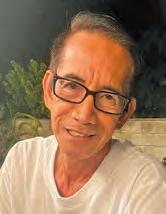
One thing that I have noticed about HFC is that it provides advocacy and representation for Filipinos. I’m referring to the rights that we have as well as the interests in our community, whether it is political or touches on social justice issues. I think that it provides a voice to underrepresented groups like newly arrived immigrants that the mainstream media tends to overlook.

What I like about the HFC is the Community Parade, where there are pictorials of birthdays, weddings, special occasions of Filipinos, and others. I want to read the opinions of writers, and I like their staff; they are really open to any topic concerning present news worldwide, not only here but abroad, but also in the Philippines in particular. It’s updated. The values and contents of the published article sometimes benefit not only the readers but even the youth, and I noticed people talk about it all around. The content is very educational, informative and offers valuable lessons to everyone. It’’s interesting to read.
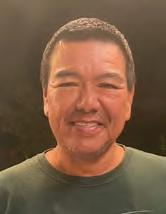
David Ako
Painter, Ewa Beach
Because I’m business-minded, I enjoy reading business-related stories or profiles of successful entrepreneurs and small business owners. Reading articles like that is good because it promotes businesses and services owned by Filipinos and also encourages our community to support them. I also like their colorful pictorial pages.
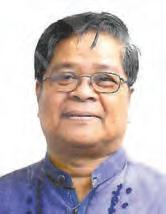
Art Eugenio
Financial Professional, Insurance Consultant, Honolulu
HFC used to have a regular column written in the Filipino language. I have not seen it for quite some time but it should be brought back because it is good to expose readers, especially non-Filipino speakers, to our language. Doing this helps to bridge any language barriers and facilities, and better understanding of issues facing Filipinos here in Hawaii and back in the Philippines. I also like to read business-related topics because it motivates me with my present position.


HFC has covered the various facets of the Filipino community in Hawaii and beyond with grace, expertise, and pride.
Behind the continued success of this Filipino ethnic newspaper are our readers and advertisers who support the mission and share the vision of HFC.
HFC managing editor Chona Montesines-Sonido said, “Ethnic media exists because the community it serves needs it. We call ourselves ‘the true voice of the Filipino community because we cover the good, the bad, and the ugly.’”
Despite the decrease in print media and the increase in social media reliability while factoring in the effects of the COVID-19 pandemic,
HFC still survives today through its adaptability during the pandemic and presence in both print and social media that are accessible to the community.
In recent years, the newspaper’s scholarship program has supported journalism and mass communication students of Filipino ancestry in Hawaii.
To give back to the community beyond the newspaper, the scholarship program was created to encourage local Filipino college students to pursue a degree in journalism and mass communication.
However, the scholarship program was paused indefinitely in 2023 due to the economic effects of the pandemic. Recently,
HFC has been rebuilding the funds needed for the program to reinstate the annual scholarship by 2025.
There are numerous ways to show support for HFC.
From reading articles and sharing them online to placing an advertisement and donating to the scholarship, the support will further HFC’s mission of advocating and raising the voice of the Filipino community.
HFC publishes two issues per month and free copies of the newspaper are available at numerous newsstands across the state of Hawaii such as Max’s Restaurant, Seafood City, Pacific Supermar-


ket, Waipahu Festival Marketplace, Golden Coin Restaurant, and various clinics by Filipino doctors and medical professionals.
Feel free to grab a free copy of HFC and share the newspaper with your family and friends.
For those who prefer a digital copy, HFC is also accessible online at https://thefilipinochronicle.com/.
Articles are posted on the website every publication date and the PDF copy of the newspaper is also available. HFC is also on the following social media platforms: Facebook: https:// www.facebook.com/ TheFilipinoChronicle Instagram: https:// www.instagram.com/ the_filipino_chronicle/
X (formerly Twitter): https://x.com/ HiFilChronicle
LinkedIn: https:// www.linkedin.com/in/ thefilipinochronicle/
For advertisers looking to target their services and products to the Filipino community, HFC’s wide range of accessibility both offline and online provides a great marketing opportunity to tap into the second-largest ethnic group in Hawaii. Head to https://thefilipinochronicle.com/advertise/ for more information.
Most importantly, proceeds from advertisers and the gracious donations of readers and supporters go towards HFC’s annual journalism scholarship program.
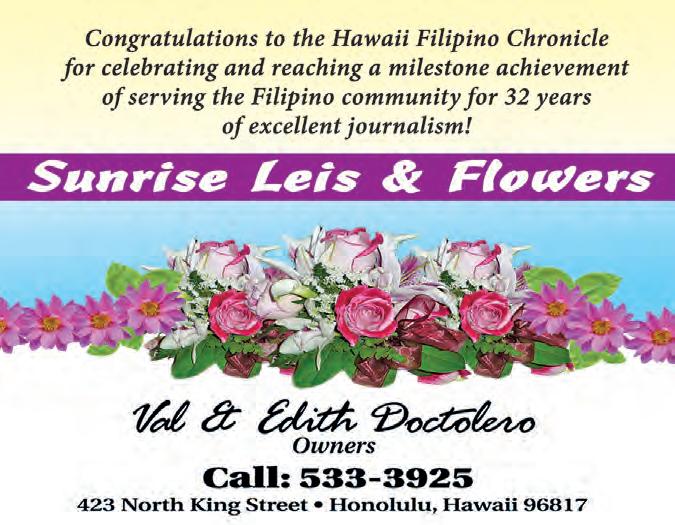


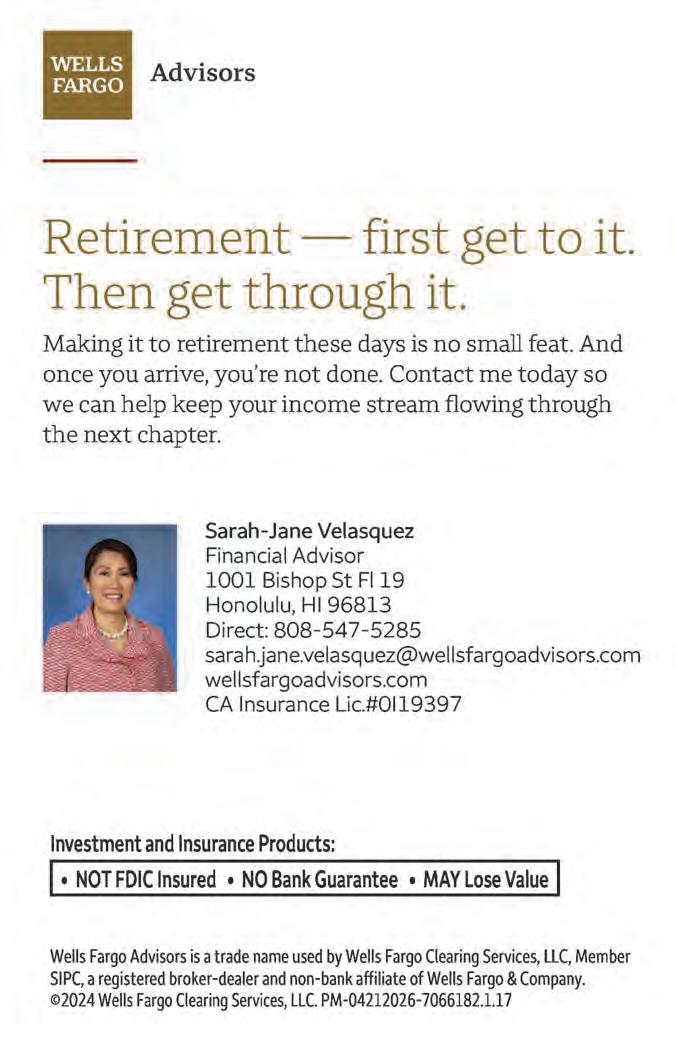

What accomplishments do you believe the Hawaii Filipino Chronicle has achieved during its 32 years of service to the community?
By HFC Staff
Hawaii Filipino Chronicle’s (HFC) Chronicle Pulse has interviewed readers and supporters regarding various topics over the years. For this issue, HFC flipped the script and reached out to its past and current staff members to reflect on the last 32 years of HFC.

In this digital age, Hawaii Filipino Chronicle’s 32 years of print journalism is truly a remarkable accomplishment. Filipinos in Hawaii benefit from having a newspaper that keeps us informed on news and events as well as fun features in the U.S. and the Philippines… for free.

The Hawaii Filipino Chronicle continuously plays a vital role for both the Filipino and the entire Hawaii community. It has a pulse on what’s happening in our community and provides a platform for our voices to be heard. It sheds light on important issues facing us and celebrates our achievements and leaders who make a difference. Our community is not only heard but also seen through the Hawaii Filipino Chronicle. It is so important to ensure that ethnic newspapers exist in a shrinking industry to cover stories that are important to us.

In this age of the proliferation of many different news platforms, the prevalence of misinformation has risen exponentially. However, for me, I can always count on the Filipino Chronicle for news that does not have to be fact-checked. It is my one news resource that I feel very confident that I am getting real news and information. The Hawaii Filipino Chronicle has made sterling accomplishments over its 32 years of publication. It is a powerful voice for the Filipino Community in Hawaii. It has provided our community with a reliable news source and a cultural touchstone.
A voice for Filipinos, culture preservation, advocacy for justice and equity, and fostering informed citizens. The Filipino Chronicle has amplified Filipino voices; by covering issues specific to the Filipino Community, it has given visibility to Filipino concerns in various topics such as immigration rights, education, and healthcare. Articles on Filipino history, heritage, and current events have allowed us a sense of unity and pride among Filipinos and Filipino-Americans in Hawaii. This has helped preserve traditions and strengthen connections between generations and with our native land the Philippines.
HFC has also advocated for social justice and equity. By reporting on and advocating for issues affecting Filipinos and other immigrant groups the Chronicle has encouraged awareness and progress in areas of racial equity and social justice. Being an informed citizen is a hallmark of democracy.
Through HFC’s thorough coverage of local and state politics, you are empowering your readers to engage in civic life and understand how policies impact their lives and families. By providing annual scholarships in journalism you are making landmark accomplishments to ensure that we have generations of journalists that will uphold the mission of journalism and the Hawaii Filipino Chronicle.
The impact of the Hawaii Filipino Chronicle is substantial, not only in the Filipino community but also across all Hawaii communities as it serves to bridge between cultures and generations.
The Chronicle’s adherence to fair, relevant, and culturally resonant journalism has made it a valuable resource that elevates the voices of the Filipino diaspora and contributes significantly to Hawaii’s diverse population.
Truth and honesty always prevail. Congratulations!

The Filipino Chronicle plays an essential role in the betterment of Hawaii, serving as both a source of culturally relevant news and a platform for preserving heritage. As Hawaii’s largest ethnic group, Filipinos face unique struggles and triumphs. For 32 years the Chronicle has highlighted issues that mainstream media often overlook.
As a former journalist and contributing writer to the Chronicle, I have deepened my appreciation for the Sakadas and the generations that benefit from their courageous decisions.
The Chronicle continues to provide a voice to Hawaii’s Filipino community by highlighting issues like immigration, discrimination, policy impacts, and outstanding achievements by local Filipinos. Maraming salamat po to the many hands that pour their souls into this bi-monthly publication. The need for advocacy and unifying messages will be needed in the decades ahead.

I’m honored to be one of the contributing writers for the Hawaii Filipino Chronicle, a publication that deeply resonates with our community. I often hear from readers of all backgrounds who connect with the stories I’ve written or those of fellow contributors. I’m proud of the Chronicle’s enduring commitment to sharing Filipino voices, especially as many media outlets have come and gone during its 32-year history.
The Chronicle spotlights stories often overlooked by other media. For example, a piece on homelessness led to a radio interview on KCCN/ KINE, while a feature on Filipino race car driver Jovy Marcelo commemorated his life and legacy. I started writing for the Chronicle in 1997, five years after its launch in 1993. I’ve cherished telling stories like Dr. Francis Duhaylongsod’s work in cardiac surgery and highlighting filmmakers such as Stephanie Castillo and Brillante Mendoza, whose work enriches our lives.
The Chronicle has earned numerous accolades, including SBA’s Small Business Journalist of the Year for Honolulu in 2006. Attending its 25th-anniversary celebration was a proud moment, as it was a joy to see the community celebrate the publication’s accomplishments, a moment I shared with my father, who hails from Balagtas, Bulacan. I credit the Chronicle for being a part of my success in my journalism career in radio, MidWeek newspaper, KHON2, and now as the Communications Director and Parent Relations Liaison at Assets School. I look forward to the Hawaii Filipino Chronicle’s continued legacy in the community.

Over the past 32 years, the Hawaii Filipino Chronicle has stood as a beacon of information and community advocacy in Hawaii. It has seen success in fostering unity among the islands’ Filipino diaspora community, helping preserve the country’s heritage, and empowering readers to stay informed, engaged, and connected to their roots through thoughtful and
in-depth coverage of issues that are relevant to Filipinos.
Whether it’s reporting on immigration policy, economic challenges, healthcare issues, or other news, the Chronicle has amplified Filipino voices in public discourse and created a platform for the community to share their stories.
Beyond covering news, the Chronicle has also advocated for education, civic engagement, social justice, and political representation. It has indeed become a cultural institution that is sure to leave a lasting legacy and impact for years to come.
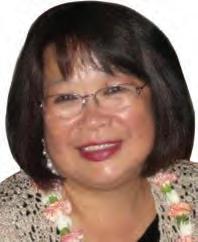
In the summer of 2023, a young scholar—a professor of sociology from Iowa—and her research assistants, visited Hawai’i to research to explain the emergence and development of conservative and right-wing ideology in U.S. politics among Filipinos. Hawai’i’s Filipinos were chosen for the pilot study because we are the oldest, largest, and most assimilated immigrant groups in the U.S. We also come from a home country modeled after American-style democracy.
One of the first activities of the research team was to converge on the Hawai’i Filipino Chronicle’s offices to do their research—poring over the past issues since the paper’s establishment 32 years ago. The papers’ previous issues were valuable sources of information on the pulse of the community, a crucial factor in assessing how our collective values and dreams have evolved.
I mentioned to the lead researcher that there are other community newspapers on the island. In essence, she noted that it would be a waste of time. The Chronicle had provided what they were looking for.
Its news stories and opinion pieces were substantive and relevant. It reflected what mattered to the community and was consistently dependable: the paper came out regularly without fail despite the State’s economic ups and downs, closure of its long-time printing press, and other woes.

If this trajectory continues, which seems to be the case, the paper will remain an important source of information on the Filipino presence in Hawai’i. It will be a valuable tool to historians and researchers, as it is now. It will keep us visible and ensure that our collective aspirations are documented to serve as a guiding light in strengthening our community.
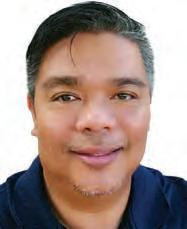
The Chronicle has received several awards from the private and public sectors over its three decades of service to the community. These awards are important for many reasons. They provide third-party validation and demonstrate excellence in the news industry. Such awards also boost community recognition and support, attract new and potential customers, and set the Chronicle apart from competitors.
Most importantly, I think these awards boost the Chronicle’s credibility—an aspect which is downright crucial in the media business. It is the cornerstone for print, television, or print news agencies. As we have seen in this presidential election, several legacy news media have reported steep declines in viewership and readership levels.
Fortunately, the Chronicle has from Day 1 made it a point to provide fair, accurate, and unbiased reporting. Our job is to present you, the reader, with facts and let you make up your own mind. The Chronicle’s mission as a news source is to inform our readers—not to elect politicians, push for tax cuts, or advocate for reforms.
We realize that credibility is hard-earned and yet easily lost. That is why our opinion columns are clearly labeled “Opinion.” That is why in the event of an error, we readily print an errata because we want to maintain the highest possible standards of integrity and professionalism.
To our valued readers, thank you for your continued support and for choosing to stay informed with our news. We deeply appreciate your taking the time to read our stories and to engage with important issues affecting Hawaii’s Filipino community.

